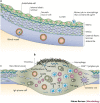Searching for the cause of Kawasaki disease--cytoplasmic inclusion bodies provide new insight
- PMID: 18364728
- PMCID: PMC7097362
- DOI: 10.1038/nrmicro1853
Searching for the cause of Kawasaki disease--cytoplasmic inclusion bodies provide new insight
Abstract
Kawasaki disease (KD) has emerged as the most common cause of acquired heart disease in children in the developed world. The cause of KD remains unknown, although an as-yet unidentified infectious agent might be responsible. By determining the causative agent, we can improve diagnosis, therapy and prevention of KD. Recently, identification of an antigen-driven IgA response that was directed at cytoplasmic inclusion bodies in KD tissues has provided new insights that could unlock the mysteries of KD.
Figures


References
-
- Landing BH, Larson EJ. Pathologic features of Kawasaki disease. Am. J. Cardiovasc. Pathol. 1987;1:218–229. - PubMed
Publication types
MeSH terms
Substances
Grants and funding
LinkOut - more resources
Full Text Sources
Other Literature Sources
Medical
Miscellaneous

